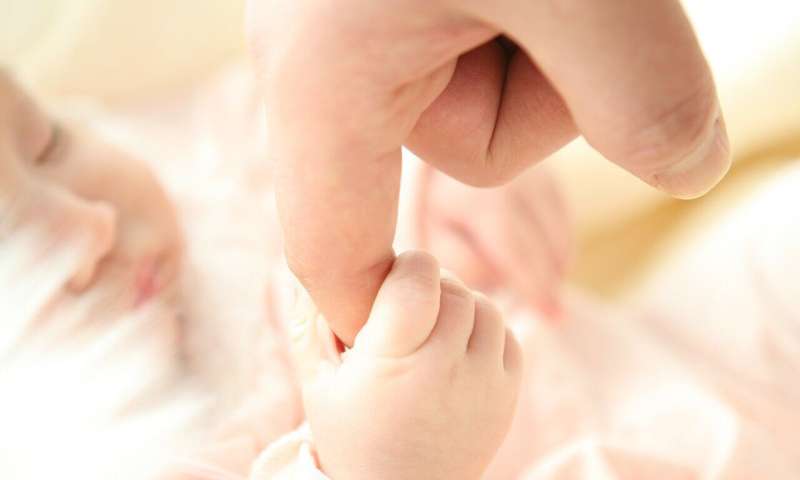Credit: CC0 Public Domain
Getting premature babies to breathe without assistance has always been a stressful mission for doctors. But by carefully ventilating babies with 100% oxygen researchers have found a way to jump-start these first independent moments.
Spontaneous breathing at birth is critical so that doctors can avoid using invasive respiratory interventions on fragile newborns. But hypoxia—a lack of adequate oxygen supply to the body—is a huge inhibitor of natural breathing and a particularly large risk for premature babies.
However, there may be hope on the horizon. Dr. Janneke Dekker and Prof. Arjan te Pas from the Leiden University Medical Centre, Netherlands and Prof. Stuart Hooper from Monash University, Australia have demonstrated how oxygen can be used to tackle this problem in two research studies, both of which feature in Frontiers in Pediatrics.
Most preterm infants need some kind of support at birth because of their low muscle strength and the fact that their lungs haven't fully developed. This assistance is generally provided non-invasively through the use of a facemask in order to avoid more complicated procedures that risk lung and brain injury. But to make the facemask effective, the preterm infants already need to be breathing on their own. So how to encourage this first breath?
It was thought that giving pure oxygen in the baby's first few moments may stimulate it to breathe deeper and more frequent, but the team needed to make sure the theory was sound in principal before moving onto clinical studies with human babies.
The first paper provided the groundwork. Dekker and colleagues divided 26 preterm rabbit kittens that had difficulty breathing into two groups that received non-invasive breathing support at birth. One group received 21% oxygen via a facemask (equivalent to the normal amount of oxygen in air) and the other received 100% oxygen. They found that giving pure oxygen immediately after birth resulted in more stable breathing as well as a better rate of breathing.
With these promising results in mind, Dekker turned her attention to clinical studies in humans.
In the second paper, Dekker used a similar technique for stimulating breathing in premature human babies. Like the first study, 52 premature babies were stabilized at birth and randomly assigned to two treatment groups. One received an initial oxygen concentration of 30% via a non-invasive facemask and the other group received an initial oxygen concentration of 100%. The amount of oxygen present in the baby's blood was measured by using a pulse oximetry probe and compared to the internationally recommended reference values. The facemask oxygen was then adjusted to maintain an oxygen level of the blood within these recommended ranges.
Their results matched their predictions: the premature babies in 100% O2 group had a higher rate of breathing effort as well as a better oxygenation rate, and ultimately needed less time of positive pressure ventilation. This meant that vital organs and tissues in these fragile infants were getting more of the precious oxygen they needed to survive and could be independent from assisted breathing sooner.
So why not give all babies 100% oxygen all the time? Because too much oxygen can also be a bad thing. It's known that high concentrations of oxygen over time can lead to hyperoxia—a potentially harmful situation that causes tissue damage. Dekker and colleagues were careful to avoid this by slowly decreasing—titrating -the excess amount of oxygen as it became clear the babies no longer need the support.
This careful balancing act of stimulating babies to breathe with excess oxygen, and then dialing it back once it's no longer needed could save lives in the future.
Before that can happen, Dekker notes that: "this clinical trial was not designed to demonstrate any significant differences in clinical outcomes, but rather provide knowledge on one of the factors that could improve breathing effort at birth. The next step will be to combine this new technique into a bundle of care and compare the outcome to current clinical practices."
While more research needs to be done before using the technique globally, Frontiers' Field Chief Editor Dr. Arjan te Pas says the findings are exciting in and of themselves:
"The finding that oxygenation is a dominant driver for breathing effort at birth is exciting as this offers the possibility to be more successful in supporting preterm infants in a non-invasive manner. The knowledge gained from this research could help us design future studies on improving the effectiveness of the use of oxygen at birth, without increasing the risks that are associated with hyperoxia."
More information: Janneke Dekker et al, The Effect of Initial High vs. Low FiO2 on Breathing Effort in Preterm Infants at Birth: A Randomized Controlled Trial, Frontiers in Pediatrics (2019). DOI: 10.3389/fped.2019.00504
Janneke Dekker et al. Increasing Respiratory Effort With 100% Oxygen During Resuscitation of Preterm Rabbits at Birth, Frontiers in Pediatrics (2019). DOI: 10.3389/fped.2019.00427
Provided by Frontiers
























